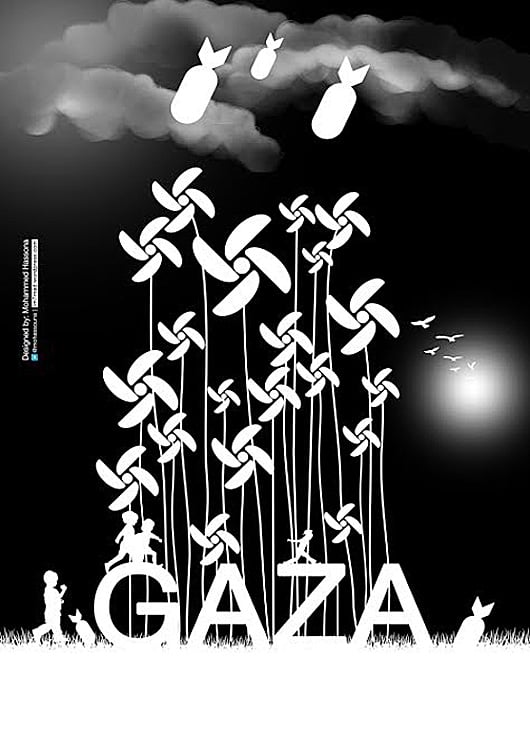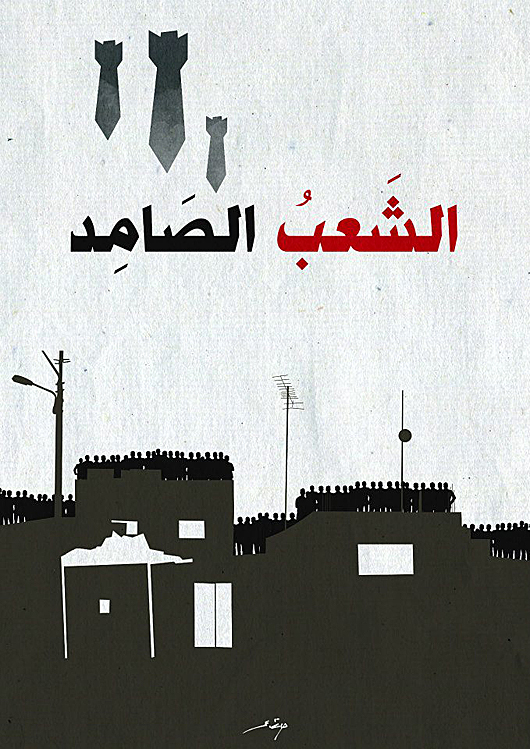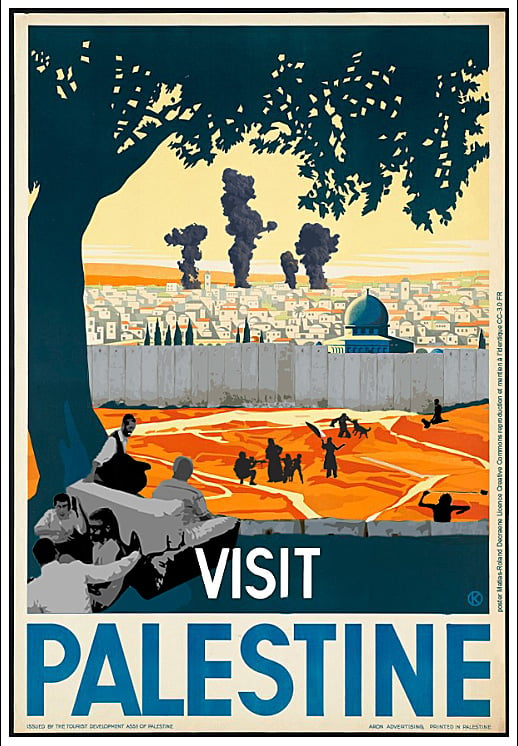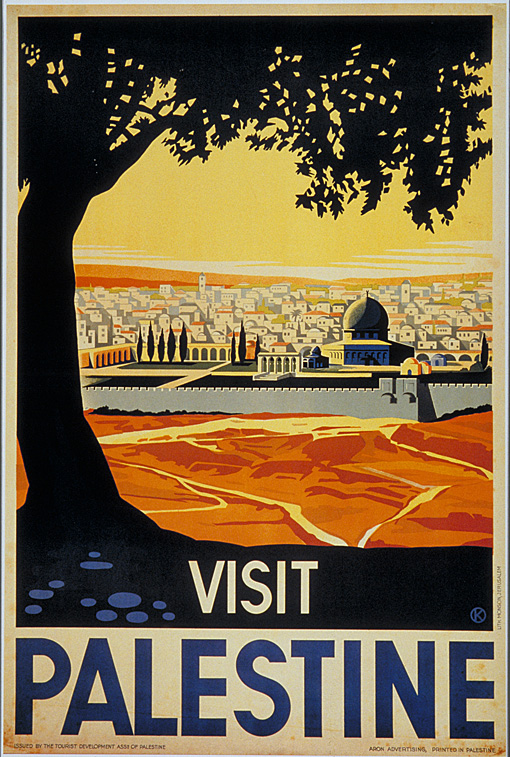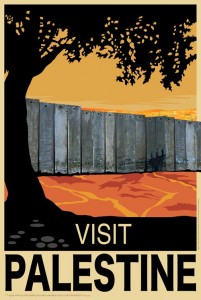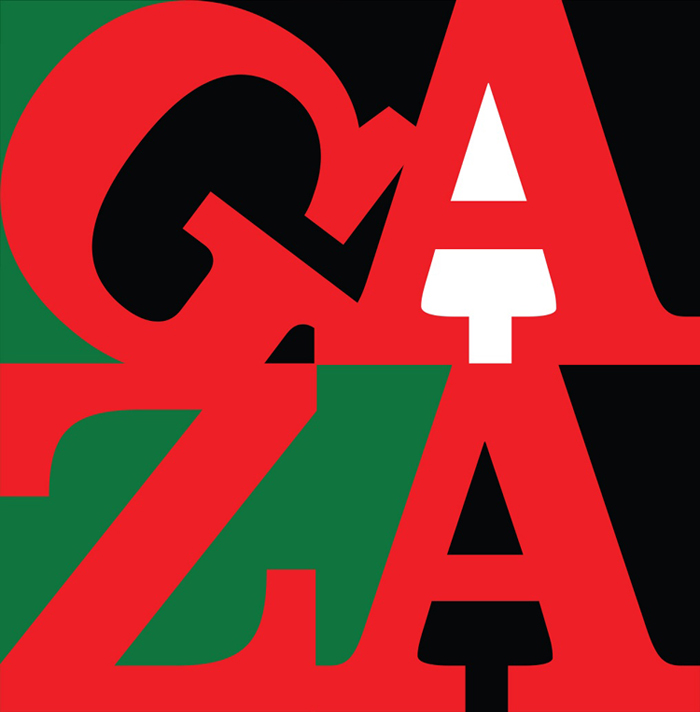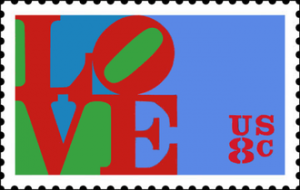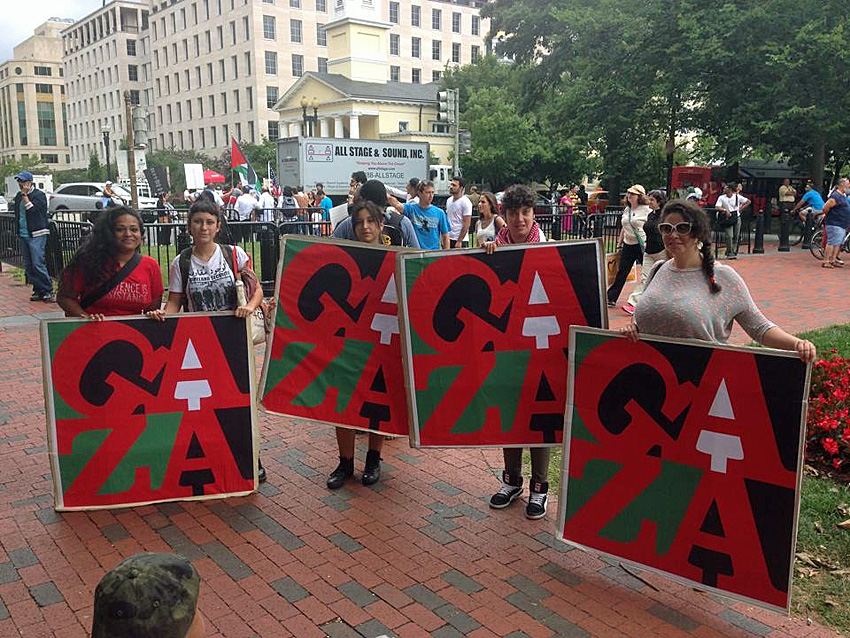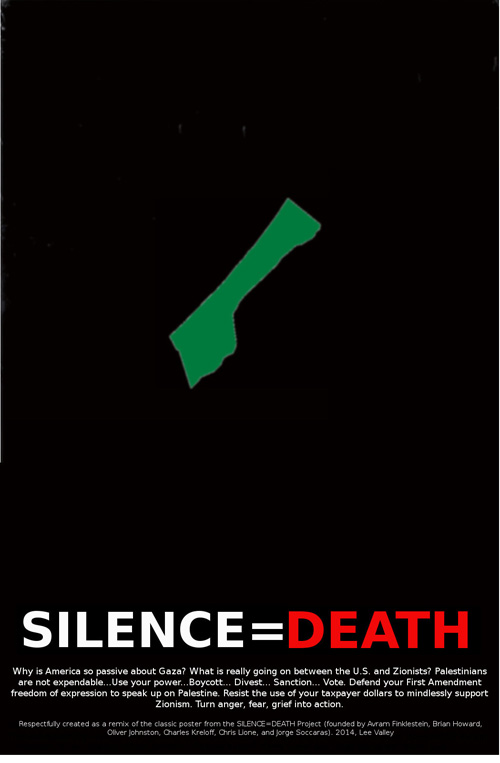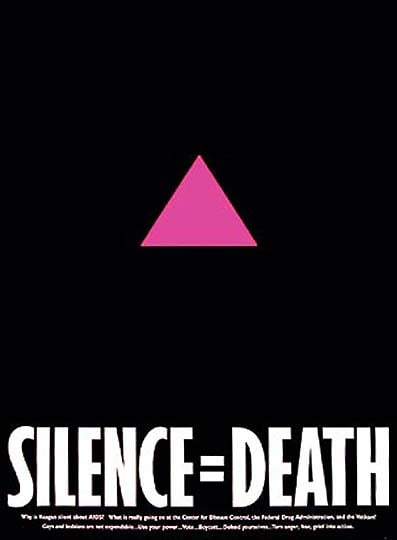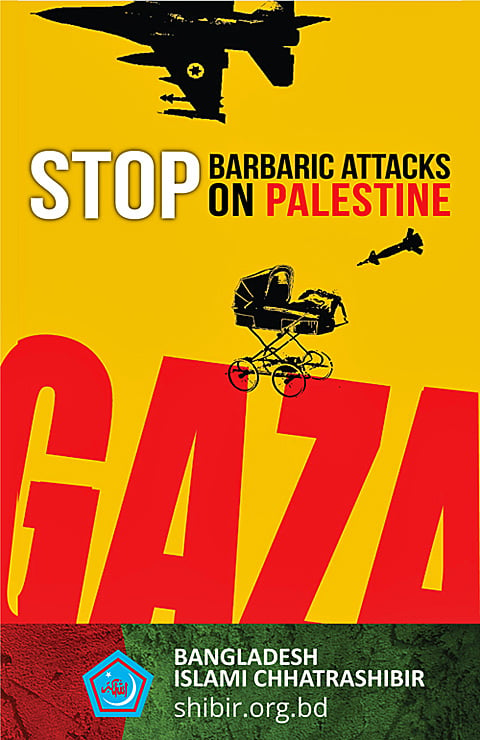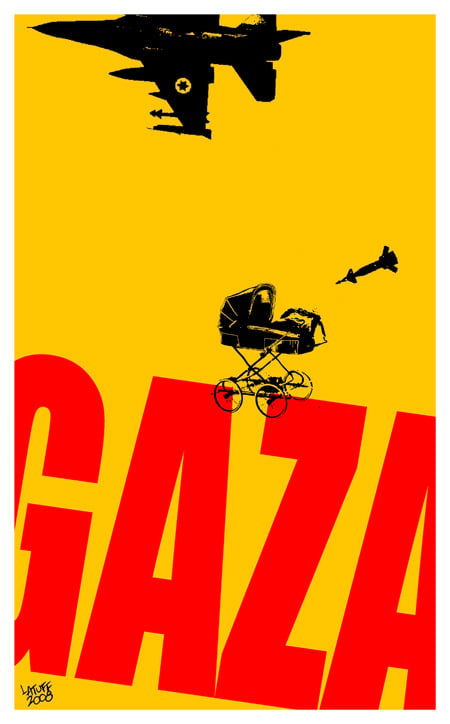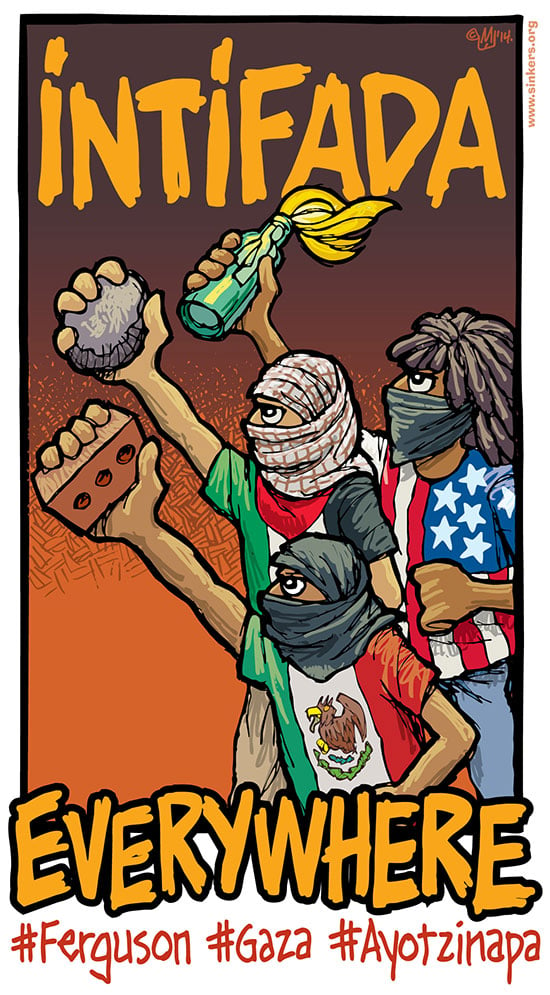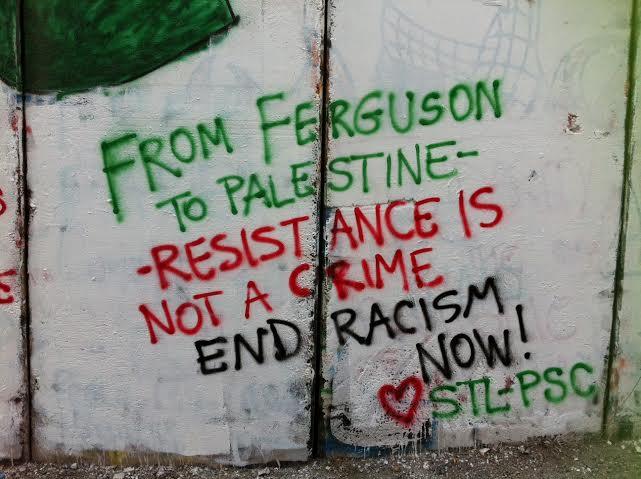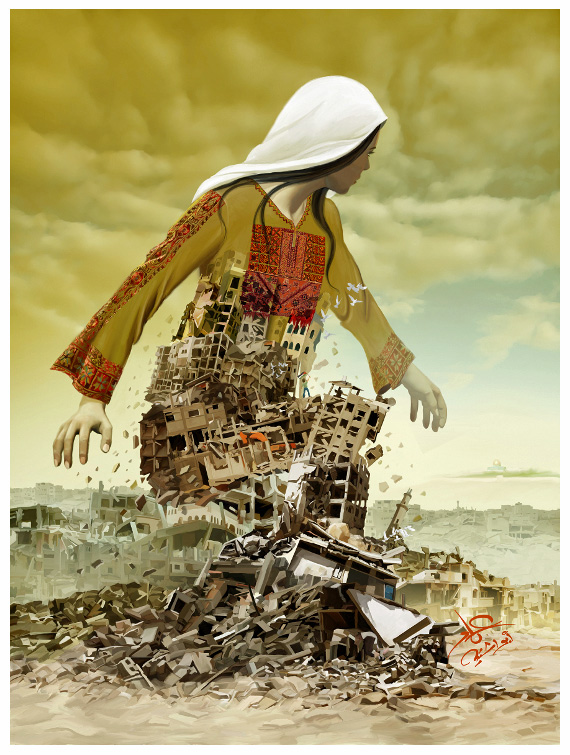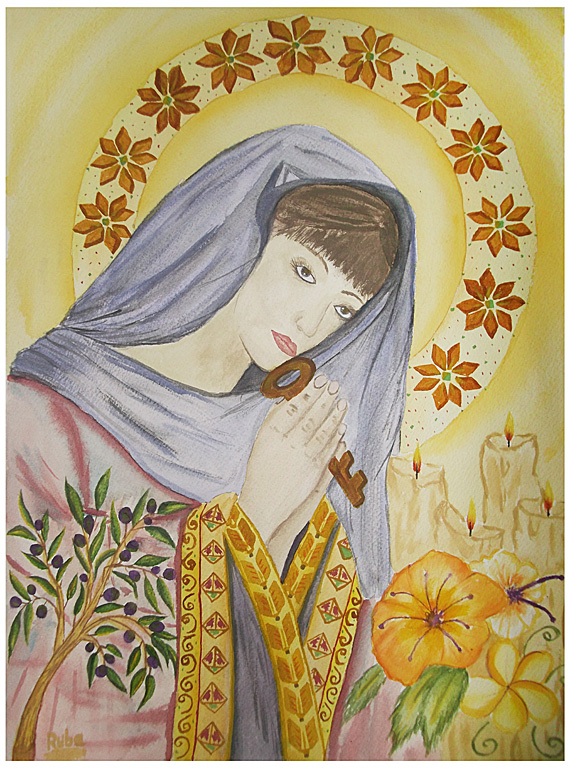Bombers, Blood, and Teddy Bears: Posters from the 2014 War on Gaza
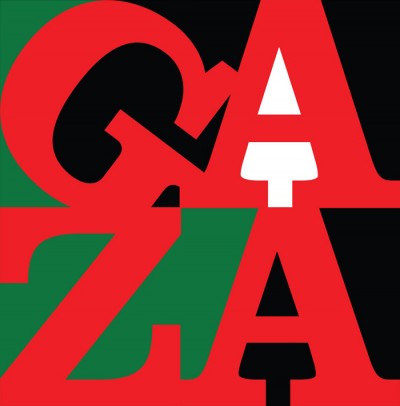
The spirits of the more than 2,000 Palestinians who were killed in Israel’s 50-day military operation against Gaza last summer have been immortalized in the posters that have emerged from the conflict. The online Palestine Poster Project Archives contains more than 175 posters on Gaza published in the past year. “Art is not a mirror held up to reality but a hammer with which to shape it,” in the words of Berthold Brecht. Ten internationally representative posters created in response to last summer’s attacks, discussed below, demonstrate the power with which artists wield their tools to record history, influence the discourse, and effect action.
Hassona is a prolific young artist from Gaza whose work has been exhibited internationally; he also displays his posters via his website, Taste of Freedom: Posters of Gaza. In this work, Hassona depicts Israeli bombs that drop through vaporous clouds and land intact, seemingly without effect. The children are not annihilated by the bombs; rather, they transform into pinwheels that rise up tall from “GAZA.” The sky may be black, but the sun is breaking through, and birds—symbolizing the dispossessed—are returning home.
Gaza Pinwheels
Mohammed Hassona (Palestine)
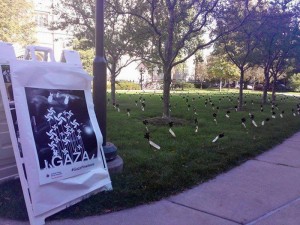 Image (R): University of Chicago, 2014 American Friends Service Committee
Image (R): University of Chicago, 2014 American Friends Service Committee
The American Friends Service Committee adopted this poster’s imagery for its Gaza Pinwheel Project, which memorialized the young victims of Israel’s military operation; according to the United Nation’s Report of the Independent Commission of Inquiry on the 2014 Gaza Conflict, 551 children were killed. In one such exhibition at the University of Chicago (below), the lawn was carpeted with black pinwheels, each bearing the name and age of one child killed. This kind of linkage demonstrates the ease by which posters in the Internet era can serve as strategic protest tools.
The Steadfast People
Hafez Omar (Palestine)
Bombs also fall in this stark poster but, as in “Gaza Pinwheels,” their descent is confronted by “the steadfast people,” as represented by the Arabic caption and the throngs standing on the rooftops. These citizens of Gaza are engaged in sumud (Arabic: steadfastness), the Palestinian form of nonviolent resistance. Their bodies against the bombs embody the vast asymmetricality of the struggle, and the human cost is suggested by the caption that is red like blood.
But there’s another way to interpret this poster: the Israeli Defense Forces, in a post entitled, “Hamas Caught Using Human Shields in Gaza,” contorts meaning to justify its war. The IDF translates the caption as “the strong people,” which it says is mere “word play” on the Hebrew name it gave to its military operation against Gaza (Tzuk Eitan, meaning “strong cliff”). Furthermore, IDF claims, “Hamas uses graphics such as [this poster] in order to assure Palestinians in Gaza that that they can become heroes by acting as human shields.” IDF did not do its research; the artist Hafez Omar did not create this poster for Hamas, and this poster is not some macabre celebration of death. Clearly, it is beyond the IDF to understand sumud.
This poster is among many images curated by a French language website, Humaginaire.
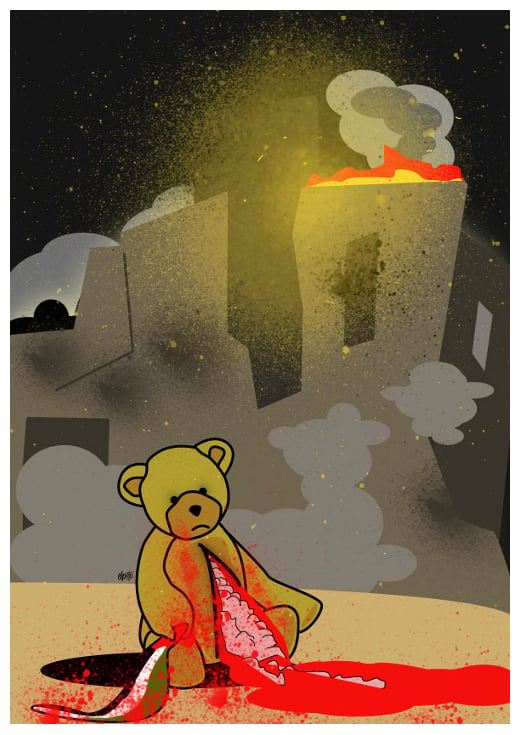 Gaza Teddy Bear
Gaza Teddy Bear
Cris Elpasolibre (Basque Country/France)
Because of the particularly heinous nature of the violence wrought by Israel, blood is a common motif in posters responding to the 2014 assault on Gaza. No text appears in Elpasolibre’s depiction of the war. The cute teddy bear appears lost, as if it fell into this scene out of the arms of some child in a picture book. But the stuffing and blood spilling out of the bear’s guts remind us that real children fell from their real mother’s arms and suffered real, gruesome injury. The teddy bear image, standing in for the 551 Gazan children killed and the 3,436 injured, is more painful to contemplate than any one photograph.
The provenance of this poster—Basque Country—speaks to the ties that connect Palestine to other national liberation movements around the world.
Yours Very Truly
Maybe Jairan Sadeghi (United States)
Blood is a motif yet again in this poster. The page is spattered with it, even though the war plane is seemingly stationary. The aircraft is identified as Israeli by the Star of David insignias, which—lest anyone label the artist anti-Semitic—appear on actual Israel Defense Forces aircraft.
The wings serve as the canvases for the bomber’s impact. The left wing presents the injured, the dead, and the bereaved; the right depicts the rubble and the smoke. The clincher is the attached tag, which reads, “Yours Very Truly, XOXO U.S.A.” It symbolizes the gift of $3+ billion in annual military aid from the U.S. to Israel. Americans are the givers of death and destruction to Gaza, by their acquiescence to the “special relationship” between the two countries through which Israel’s weapons of war are financed.
“Yours Very Truly” is one of many posters curated at the Tumblr site, Handela Has A Posse, which is dedicated to “art in solidarity with Palestine and the Palestinian call for boycott, divestment and sanctions.”
Visit Palestine
Matias Roland Decraene (France)
The original intent of the iconic 1936 Franz Krausz poster (below) was to promote tourism to the land that was only redesignated as “Israel” in 1948. A 1995 reprint by Israeli artist David Tartakover has been immensely popular among Palestinians, internationals, and, to some degree, Israelis. “Visit Palestine” has generated so many remixes that it has become a subgenre of posters unto itself. (For more on the iconographic history of this poster, read “‘Visit Palestine’: A Brief Study of Palestine Posters” by Rochelle Davis and Dan Walsh; a gallery of remixes is available at the Palestine Poster Project Archives).
In 2009, the Ramallah-based artist Amer Shomali created a version (left) that relocates the Apartheid Wall into this setting. The poster was selected in a call for posters by Imaging Apartheid and was distributed internationally by the artists’ cooperative, Justseeds. In Decraene’s Gaza-inspired remix, the Apartheid Wall remains but Jerusalem and the Dome of the Rock are visible behind it, with the bombing of Gaza as backdrop.
Image (R): Amer Shomali
In the foreground Decraene places several tableaus: Israelis who have set up couches on the hillside to be entertained by the spectacle of war; an Israeli-trained attack dog in action; Palestinians resisting with flag and slingshot; and an individual kneeling in prayer. At least one of these images is adapted from a photograph (see Slide 5 in “Sderot Cinema: Bombing of Gaza”); possibly all of them are. The geographic placements are not literally accurate; the juxtaposition suggests that the Wall, the Holy City, Gaza, and interactions with Zionist oppressors form a unified reality for Palestinians.
Gaza Love
Kyle Goen (United States)
Goen’s modus operandi, according to his website, is to use “found imagery and repurposed national symbols” to explore social justice themes. Here, Goen makes use of the iconographic “LOVE” lettering first rendered in a 1970 sculpture by Robert Indiana and later featured on the first stamp on the theme of love to be issued by the U.S. Postal Service, in 1973 (below).
Goen’s transformation of the word “LOVE” into “GAZA” is provocative yet disarming, associating love with a geographical location that Americans have neglected, ignored, misunderstood, and defamed. The familiar, joyful lettering, recast in a bold palette (the Palestinian colors of red, black, white, and green), compels a reconsideration of “Gaza.” For those already in solidarity with Palestine, it affirms the affection. The genius of this poster is that the image can be interpreted from yards away. This made it extremely popular with demonstrators in the summer of 2014 (below).
Silence=Death
Lee Valley (United States)
According to the credits line, this poster was “respectfully created as a remix of the classic poster from the SILENCE=DEATH Project” (below), which launched in 1987 in response to the AIDS crisis.
The Gaza map stands in for the pink triangle from the original, and the palette has been adjusted to the Palestinian colors. The caption copy also shows deference. The original text reads:
Why is Reagan silent about AIDS? What is really going on at the Center for Disease Control, the Food and Drug Administration, and the Vatican? Gays and lesbians are not expendable…Use your power…Vote…Boycott…Defend yourselves…Turn anger, fear, grief into action.”
The Gaza remix reads in parallel:
Why is America so passive about Gaza? What is really going on between the U.S. and Zionists? Palestinians are not expendable… Use your power… Boycott…Divest…Sanction… Vote. Defend your First Amendment freedom of expression to speak up on Palestine. Resist the use of your taxpayer dollars to mindlessly support Zionism. Turn anger, fear, grief into action.”
The artist says, “I was living in Washington, DC in the late eighties when SILENCE=DEATH posters were pasted up around the city. The image and text were so direct that no one could avoid the message. My idea was to create an equally unavoidable message about the ongoing situation in Gaza.”
Stop Barbaric Attacks On Palestine
Carlos Latuff (Brazil)
The missile targeting the baby carriage suggests the depersonalized warfare on innocents practiced by the Israeli Air Force. Latuff, a political cartoonist, created the original poster (below) in response to Israel’s attack on Gaza in 2009; the above was remixed by an Islamic Bangladeshi student organization following the 2014 recurrence of warfare.
Latuff’s graphics are available through the online community showcase, Deviant Art; this image has been adopted and adapted by groups and artists around the world. Latuff’s original is a commentary; the Bangladesh group’s addition of a caption, “Stop barbaric attacks on Palestine,” transforms the work into a call to action.
Intifada Everywhere
Mike Flugennock (United State)
This poster fuses three contemporaneous events: the war on Gaza launched by Israel on July 8; Michael Brown’s killing by a police officer in Ferguson, Missouri, on August 9; and the disappearance of 43 students from Ayotzinapa teachers school after being taken into police custody in Guerrero, Mexico, on September 26. “Ferguson to Palestine” is now a rallying cry (see slogan on the Apartheid Wall, below) and an organizing principle. The ties between these three movements will not likely be undone, and this can only benefit Palestine.
In Flugennock’s poster, the three men are similar in their stance and determination but unique in their garb and choice of weapon. The caption, “Intifada Everywhere,” can be read in at least two ways: “There are uprisings going on everywhere,” and, “There is a right to rise up wherever there is injustice.”
The large hashtags are a new element for Palestine posters. These direct the audience via social media into specific conversations and actions. In this way the poster becomes more than a statement; it serves as a signpost.
From the Destruction (We Shall Return)
Imad Abu Shtayyah (Jordan)
Like a phoenix rising, a Palestinian woman is re-forming out of the wreckage of Gaza. She has her eyes fixed on Jerusalem as if she gains strength from it. The woman looks so alive that she appears to be the creation of a Hollywood action movie’s computer-generated effects. But in fact the original of this graphic was created in oil; the 59×78-inch painting now hangs in a private museum in Lebanon, and the poster is an electronic reworking.
Abu Shtayyah, who was born in Jordan to a family forced out of Palestine during the Nakba in 1948, has written a poem about this piece. It appears on his Facebook page and reads in part:
From the destruction and hatred you sow
From every inch of our land
That hosted a martyr
We shall return…We shall return to our land
To the land of our ancestors!
Strong, dignified women are a recurring theme in Palestinian posters, as exemplified by the 2014 poster by Ruba Qumseya (below), which was an entry in the 2014 poster contest of the BADIL Resource Center for Palestinian Residency and Refugee Rights. According to the UN report, 299 women were killed and 3,540 injured in the 50-day assault by Israel. These many victims, the poster by Abu Shtayyah suggests, will be redeemed.
The author is indebted to Dan Walsh, curator and founder of the Palestine Poster Project Archives, for his assistance with this article. Catherine Baker is a member of the Advisory Board of the Palestine Poster Project Archives. She is also a mentor in We Are Not Numbers, a project designed to promote the work of Gaza writers.


